After almost a decade of work, an international team of astronomers has published the most detailed images yet seen of galaxies beyond our own, revealing their inner workings in unprecedented detail. The images were created from data collected by the Low Frequency Array (LOFAR), a radio telescope built and maintained by ASTRON, LOFAR is a network of more than 70,000 small antennae spread across nine European counties, with its core in Exloo, the Netherlands. The results come from the team’s years of work, led by Dr Leah Morabito at Durham University. The team was supported in the UK by the Science and Technology Facilities Council (STFC).
As well as supporting science exploitation, STFC also funds the UK subscription to LOFAR including upgrade costs and operation of its LOFAR station in Hampshire.
PUBLISHED BY THE EDITORIAL TEAM, 17 AUGUST 2021
Revealing a hidden universe of light in HD
The universe is awash with electromagnetic radiation, of which visible light comprises just the tiniest slice. From short-wavelength gamma rays and X-rays, to long-wavelength microwave and radio waves, each part of the light spectrum reveals something unique about the universe.
The LOFAR network captures images at FM radio frequencies that, unlike shorter wavelength sources like visible light, are not blocked by the clouds of dust and gas that can cover astronomical objects. Regions of space that seem dark to our eyes, actually burn brightly in radio waves – allowing astronomers to peer into star-forming regions or into the heart of galaxies themselves.
The new images, made possible because of the international nature of the collaboration, push the boundaries of what we know about galaxies and super-massive black holes. A special issue of the scientific journal Astronomy & Astrophysics is dedicated to 11 research papers describing these images and the scientific results.

A compilation of the science results. Credit from left to right starting at the top: N. Ramírez-Olivencia et el. [radio]; NASA, ESA, the Hubble Heritage Team (STScI/AURA)-ESA/Hubble Collaboration and A. Evans (University of Virginia, Charlottesville/NRAO/Stony Brook University), edited by R. Cumming [optical], C. Groeneveld, R. Timmerman; LOFAR & Hubble Space Telescope,. Kukreti; LOFAR & Sloan Digital Sky Survey, A. Kappes, F. Sweijen; LOFAR & DESI Legacy Imaging Survey, S. Badole; NASA, ESA & L. Calcada, Graphics: W.L. Williams.
Better resolution by working together
The images reveal the inner-workings of nearby and distant galaxies at a resolution 20 times sharper than typical LOFAR images. This was made possible by the unique way the team made use of the array.
The 70,000+ LOFAR antennae are spread across Europe, with the majority being located in the Netherlands. In standard operation, only the signals from antennae located in the Netherlands are combined, and creates a ‘virtual’ telescope with a collecting ‘lens' with a diameter of 120 km. By using the signals from all of the European antennae, the team have increased the diameter of the ‘lens’ to almost 2,000 km, which provides a twenty-fold increase in resolution.
Unlike conventional array antennae that combine multiple signals in real time to produce images, LOFAR uses a new concept where the signals collected by each antenna are digitised, transported to central processor, and then combined to create an image. Each LOFAR image is the result of combining the signals from more than 70,000 antennae, which is what makes their extraordinary resolution possible.

This shows real radio galaxies from Morabito et al. (2021). The gif fades from the standard resolution to the high resolution, showing the detail we can see by using the new techniques. Credit: L.K. Morabito; LOFAR Surveys KSP
Revealing jets and outflows from super-massive black holes
Super-massive black holes can be found lurking at the heart of many galaxies and many of these are ‘active’ black holes that devour in-falling matter and belch it back out into the cosmos as powerful jets and outflows of radiation. These jets are invisible to the naked eye, but they burn bright in radio waves and it is these that the new high-resolution images have focused upon.
Dr Neal Jackson of The University of Manchester, said: “These high resolution images allow us to zoom in to see what’s really going on when super-massive black holes launch radio jets, which wasn’t possible before at frequencies near the FM radio band,”
The team’s work forms the basis of nine scientific studies that reveal new information on the inner structure of radio jets in a variety of different galaxies.

Hercules A is powered by a supermassive black hole located at its centre, which feeds on the surrounding gas and channels some of this gas into extremely fast jets. Our new high-resolutions observations taken with LOFAR have revealed that this jet grows stronger and weaker every few hundred thousand years. This variability produces the beautiful structures seen in the giant lobes, each of which is about as large as the Milky Way galaxy. Credit: R. Timmerman; LOFAR & Hubble Space Telescope
A decade-long challenge
Even before LOFAR started operations in 2012, the European team of astronomers began working to address the colossal challenge of combining the signals from more than 70,000 antennae located as much as 2,000 km apart. The result, a publicly-available data-processing pipeline, which is described in detail in one the scientific papers, will allow astronomers from around the world to use LOFAR to make high-resolution images with relative ease.
Dr Leah Morabito of Durham University, said: “Our aim is that this allows the scientific community to use the whole European network of LOFAR telescopes for their own science, without having to spend years to become an expert.”
Super images require supercomputers
The relative ease of the experience for the end user belies the complexity of the computational challenge that makes each image possible. Because LOFAR doesn’t just ‘take pictures’ of the night sky, it must stitch together the data gathered by more than 70,000 antennae, which is a huge computational task. To produce a single image, more than 13 terabits of raw data per second – the equivalent of more than a three hundred DVDs – must be digitised, transported to a central processor and then combined.
Frits Sweijen of Leiden University, said: “To process such immense data volumes we have to use supercomputers. These allow us to transform the terabytes of information from these antennas into just a few gigabytes of science-ready data, in only a couple of days.”
Media
All images and video's belonging to this press release can be found in high resolution here.
Links to Arxiv (free) papers can be found here.
About LOFAR
The International LOFAR Telescope is a trans-European network of radio antennas, with a core located in Exloo in the Netherlands. LOFAR works by combining the signals from more than 70,000 individual antenna dipoles, located in ‘antenna stations’ across the Netherlands and in partner European countries. The stations are connected by a high-speed fibre optic network, with powerful computers used to process the radio signals in order to simulate a trans-European radio antenna that stretches over 1,300 kilometres. The International LOFAR Telescope is unique, given its sensitivity, wide field-of-view, and image resolution or clarity. The LOFAR data archive is the largest astronomical data collection in the world.
LOFAR was designed, built and is presently operated by ASTRON, the Netherlands Institute for Radio Astronomy. France, Germany, Ireland, Italy, Latvia, the Netherlands, Poland, Sweden and the UK are all partner countries in the International LOFAR Telescope.
Breathtaking New Images Reveal Several Distant Galaxies in Unprecedented Detail
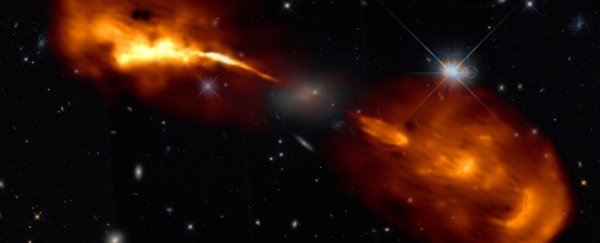
Hercules A. (R. Timmerman; LOFAR & Hubble Space Telescope)
SPACE
MICHELLE STARR
19 AUGUST 2021
A telescope network that has spent years staring into deep space has finally delivered some of the most gloriously detailed images we've ever seen of other galaxies.
Not only are these images spectacularly beautiful, they reveal in unprecedented detail the inner workings of these giant cosmic objects, giving us new insight into how galaxies work in general. The findings made so far have been published in a special issue of Astronomy & Astrophysics.
The observations were made using the Low Frequency Array (LOFAR), the largest low-frequency radio telescope network currently operating on Earth. It can combine observations from around 70,000 antennas spread across Europe using a technique called radio interferometry to take some of the most sensitive radio observations possible of the night sky.
This has given us some incredible new information about the Universe, but the new observations are taking it a step further, with a resolution 20 times higher than usual. This is because standard LOFAR operations are conducted only using the antennas in the Netherlands, where the collaboration is headquartered.
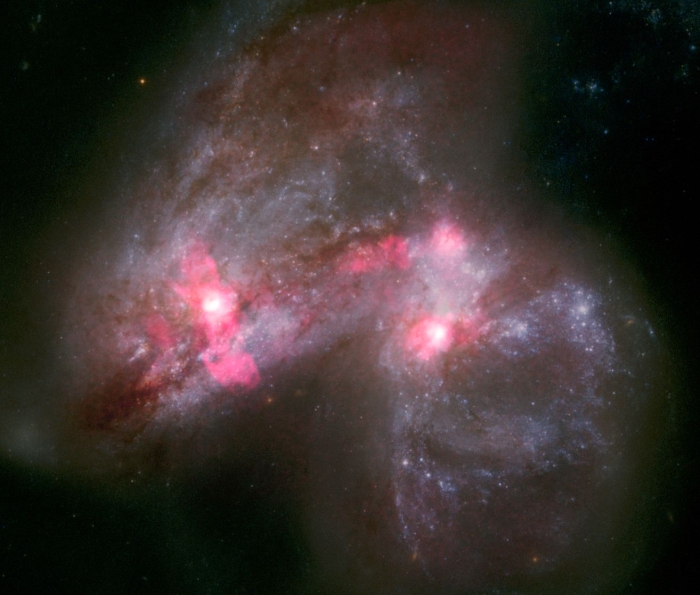
Above: Radio imaging reveals a huge wind blowing from merging galaxies. (N. Ramírez-Olivencia et al.; NASA, ESA, the Hubble Heritage Team (STScI/AURA)-ESA/Hubble Collaboration and A. Evans

Hercules A. (R. Timmerman; LOFAR & Hubble Space Telescope)
SPACE
MICHELLE STARR
19 AUGUST 2021
A telescope network that has spent years staring into deep space has finally delivered some of the most gloriously detailed images we've ever seen of other galaxies.
Not only are these images spectacularly beautiful, they reveal in unprecedented detail the inner workings of these giant cosmic objects, giving us new insight into how galaxies work in general. The findings made so far have been published in a special issue of Astronomy & Astrophysics.
The observations were made using the Low Frequency Array (LOFAR), the largest low-frequency radio telescope network currently operating on Earth. It can combine observations from around 70,000 antennas spread across Europe using a technique called radio interferometry to take some of the most sensitive radio observations possible of the night sky.
This has given us some incredible new information about the Universe, but the new observations are taking it a step further, with a resolution 20 times higher than usual. This is because standard LOFAR operations are conducted only using the antennas in the Netherlands, where the collaboration is headquartered.

Above: Radio imaging reveals a huge wind blowing from merging galaxies. (N. Ramírez-Olivencia et al.; NASA, ESA, the Hubble Heritage Team (STScI/AURA)-ESA/Hubble Collaboration and A. Evans
(UVA Charlottesville/NRAO/Stony Brook University); R. Cumming)
Since these antennas are spread across a region of 120 kilometers (75 miles), this means the telescope 'aperture' is, effectively, around 120 kilometers in size. For the new observations, an international collaboration used the entire array from across Europe - effectively, a 2,000-kilometer (1,243-mile) radio telescope.
"Our aim is that this allows the scientific community to use the whole European network of LOFAR telescopes for their own science, without having to spend years to become an expert," said astronomer Leah Morabito of Durham University in the UK.
Nine papers in the special issue of Astronomy & Astrophysics are devoted to one of the most amazing phenomena associated with galactic behavior - relativistic particle jets blasted out into intergalactic space by active supermassive black holes at the centers of galaxies.
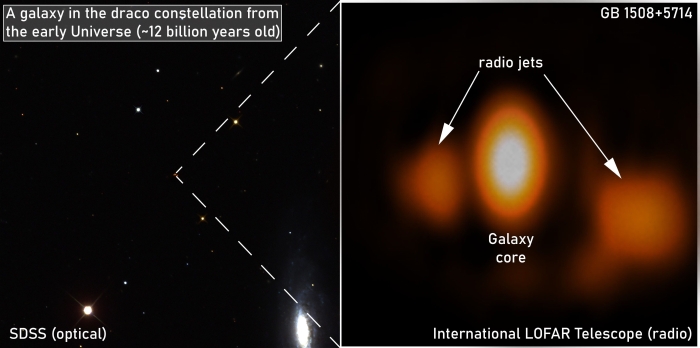
Since these antennas are spread across a region of 120 kilometers (75 miles), this means the telescope 'aperture' is, effectively, around 120 kilometers in size. For the new observations, an international collaboration used the entire array from across Europe - effectively, a 2,000-kilometer (1,243-mile) radio telescope.
"Our aim is that this allows the scientific community to use the whole European network of LOFAR telescopes for their own science, without having to spend years to become an expert," said astronomer Leah Morabito of Durham University in the UK.
Nine papers in the special issue of Astronomy & Astrophysics are devoted to one of the most amazing phenomena associated with galactic behavior - relativistic particle jets blasted out into intergalactic space by active supermassive black holes at the centers of galaxies.

(A. Kappes)
These are invisible in optical wavelengths, but in radio wavelengths, they gleam - which means radio images can give us some insight into how the jets form and propagate.
It's common knowledge that, once anything passes the critical threshold called the event horizon, nothing can escape the gravitational pull of a black hole. But the region around an active black hole is wildly dynamic. Material is spun into a disk that circles the black hole, spooling into it like water down a drain.
From the inner rim of this accretion disk, a small amount of the swirling material is somehow funneled around the outside of the event horizon towards the poles, where it is launched at speeds that are a significant percentage of the speed of light. Scientists believe that the magnetic field lines around the black hole act as a synchrotron, accelerating these particles to produce relativistic speeds.
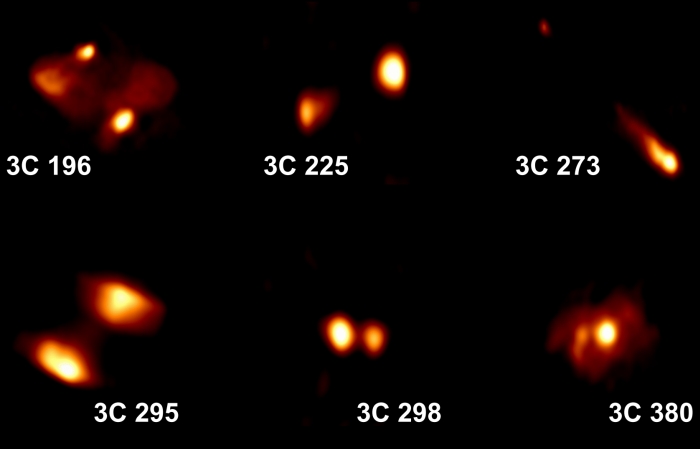
These are invisible in optical wavelengths, but in radio wavelengths, they gleam - which means radio images can give us some insight into how the jets form and propagate.
It's common knowledge that, once anything passes the critical threshold called the event horizon, nothing can escape the gravitational pull of a black hole. But the region around an active black hole is wildly dynamic. Material is spun into a disk that circles the black hole, spooling into it like water down a drain.
From the inner rim of this accretion disk, a small amount of the swirling material is somehow funneled around the outside of the event horizon towards the poles, where it is launched at speeds that are a significant percentage of the speed of light. Scientists believe that the magnetic field lines around the black hole act as a synchrotron, accelerating these particles to produce relativistic speeds.

This is what distant jets look like at super-low frequencies. (C. Groeneveld)
There is a lot we don't understand about this process, however, and the new LOFAR data are helping to fill in the missing pieces.
"These high-resolution images allow us to zoom in to see what's really going on when supermassive black holes launch radio jets, which wasn't possible before at frequencies near the FM radio band," explained astronomer Neal Jackson from The University of Manchester in the UK.
The galaxies analyzed include 3C 293, a galaxy with huge, peculiar radio lobes that suggest interrupted jet flow. The researchers concluded that the galaxy has undergone multiple periods of activity due to jet disruptions and intermittent fueling, suggesting its supermassive black hole has undergone at least one dormant period.
Another paper analyzed light from a galaxy that had traveled more than 11 billion light-years - usually quite challenging to observe in detail at low frequencies.
This observation allowed a probe into why such distant radio galaxies exhibit specific signatures; ultimately, no conclusive answer could be found, but the observation does pave the way for more in the future.
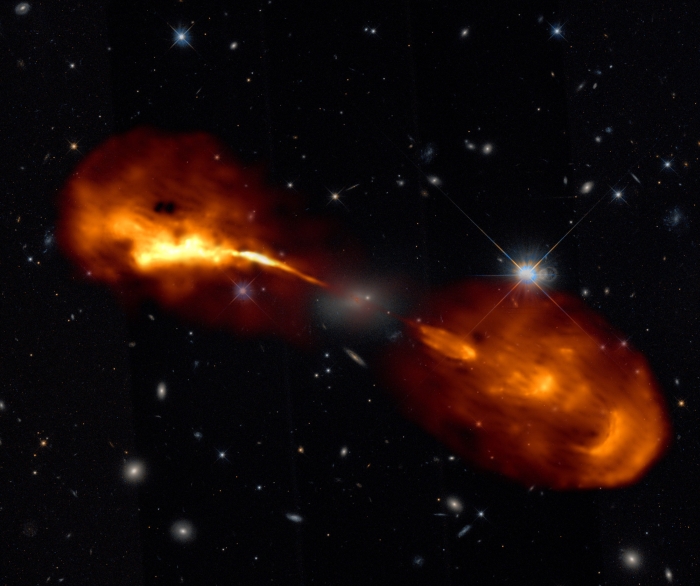
There is a lot we don't understand about this process, however, and the new LOFAR data are helping to fill in the missing pieces.
"These high-resolution images allow us to zoom in to see what's really going on when supermassive black holes launch radio jets, which wasn't possible before at frequencies near the FM radio band," explained astronomer Neal Jackson from The University of Manchester in the UK.
The galaxies analyzed include 3C 293, a galaxy with huge, peculiar radio lobes that suggest interrupted jet flow. The researchers concluded that the galaxy has undergone multiple periods of activity due to jet disruptions and intermittent fueling, suggesting its supermassive black hole has undergone at least one dormant period.
Another paper analyzed light from a galaxy that had traveled more than 11 billion light-years - usually quite challenging to observe in detail at low frequencies.
This observation allowed a probe into why such distant radio galaxies exhibit specific signatures; ultimately, no conclusive answer could be found, but the observation does pave the way for more in the future.

(R. Timmerman; LOFAR & Hubble Space Telescope)
And a probe into the spectacular radio galaxy Hercules A examined ring structures in its radio lobes. These, the researchers concluded, were the result of intermittent strengthening and weakening of the jets, producing the observed structures.
These clues can help us to understand the processes that produce and shape radio jets, but the collected work has much deeper implications. The papers also represent a significant milestone in radio astronomy, demonstrating the capabilities of a network like LOFAR for understanding the mysteries of the Universe.
The series of papers have been published in Astronomy & Astrophysics.
And a probe into the spectacular radio galaxy Hercules A examined ring structures in its radio lobes. These, the researchers concluded, were the result of intermittent strengthening and weakening of the jets, producing the observed structures.
These clues can help us to understand the processes that produce and shape radio jets, but the collected work has much deeper implications. The papers also represent a significant milestone in radio astronomy, demonstrating the capabilities of a network like LOFAR for understanding the mysteries of the Universe.
The series of papers have been published in Astronomy & Astrophysics.
No comments:
Post a Comment